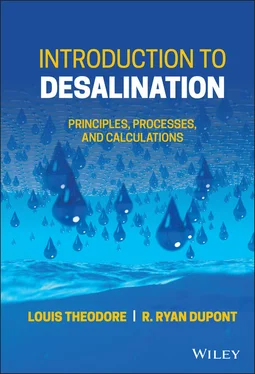2 Potable and General Use Water. The water required for general purposes on a site is usually taken from a local municipal or private supplier, unless a cheaper source of suitable quality water (e.g. a river, lake, or well) is available. If the cost of this supply is low, incentives for water use reduction will also be low. It should be remembered, however, that the cost of the supply may be a small portion of the overall cost of managing this water, particularly if it is used in process rinsing, general facility cleaning and wash-down, etc. More water use requires more energy to convey it from the source and within a plant. When the water becomes contaminated, costs for its handling increase exponentially. In addition, waste treatment becomes progressively less efficient and more costly as a waste stream is diluted, and load penalties may be incurred based on the volume of waste discharged to publicly owned treatment works (POTWs). It should be evident, then, that numerous benefits can be associated with increased water use efficiency within a plant.
3 Demineralized Water. Water from which all the minerals have been removed by ion exchange must be used where ultrapure water is needed to meet process demands and strict boiler feedwater requirements. Mixed and multiple-bed ion exchange units are used for this purpose, with resins exchanging multivalent cations for hydrogen. Boiler water as condensed steam and process water must be removed on a routine basis (blow down) to prevent the build-up of unwanted constituents within these systems, and this ultrapure water may be effectively reused within a plant for other unit operations that demand much less stringent water quality characteristics, i.e., cooling water, process rinse water, and so on.
4 Refrigeration. Refrigeration is needed for processes that require temperatures below those that can be economically obtained with cooling water. Chilled water can be used to lower process temperatures down to approximately 10°C. For lower temperatures, to -30°C, salt brines (NaCl and CaCl2) are used to distribute the “refrigeration” around the site from a central refrigeration unit. Vapor compression machines are normally used for this purpose. As with boilers, evaluation of the operating conditions of a chiller can lead to significant pollution prevention opportunities. Consider, for example, that a 1% improvement in chiller efficiency can be expected for each 1°F increase in the chiller set point.
5 Steam. The steam for process heating is generated in either fire - or water-tube boilers, using the most economical fuel available. The process temperatures required can usually be obtained with low-pressure steam (typically 25 psig), with higher steam pressures needed only for high process temperature requirements. A significant pollution prevention, energy conservation, and cost reduction opportunity may exist in a facility’s steam generation system, as many facilities operate at higher than necessary steam pressures, increasing their energy demands for steam production and the cost of producing this steam. In addition, repair and replacement of leaking steam and condenser lines will prevent the wasting of steam and the associated energy and cost needed to produce this wasted steam.
1.7.3 Illustrative Example 3
Briefly describe the wastewater streams typically generated in the petroleum industry.
Solution . Throughout the life cycle of crude oil, through extraction, transportation, and refining, roughly 5 to 7 gal of water are used for every 1 gal of crude oil processed. Of this total, roughly l to 2.5 gal of water are used for every 1 gal of crude oil stock. In the United States, 1 to 2 billion gal of water are used per day in the refining industry. Water consumption varies for different regions and different qualities of crude oil. These water estimates do not include unconventional shale formations, where water usage is generally much higher. Water consumption in refining is a result of evaporation and drilling, blowdown, process discharge, and some incorporation into finished products. All water that is incorporated into the refining process is treated or filtered onsite before it is either reused on site or discharged into the environment.
Wastewater streams include separation process wastewater, tank bottoms, cooling tower condensate blowdown, source water treatment, and storm water. American Petroleum Institute (API) separators are commonplace in most refineries and separate sludge and hydrocarbon components out of process wastewater. Refineries today have installed dike systems to keep process wastewater from draining into storm sewers.
1.7.4 Illustrative Example 4
Refer to Table 1.5and calculate the desalination mass capture efficiency of salt in seawater to convert typical seawater to potable water. Assume a basis of 100 g of seawater.
Table 1.5 Seawater and potable water major components.
|
H 2O, wt% |
Salt, wt% |
| Seawater |
96.5 |
3.5 |
| Potable water |
≥99.95 |
≤0.05 |
Solution . For 100 g of seawater,
Salt in seawater = 3.5 g
Salt in potable water = 0.05 g
The required salt capture efficiency, SCE , is therefore:

1.7.5 Illustrative Example 5
Mekonnen and Hoekstra (2011) provide a summary of national water footprints of production and consumption for countries around the world. They provide a guideline for the determination of the representative water footprint of various commodities that may be both produced within a country as well as imported for consumption from elsewhere around the globe. An example that is provided determines the average water footprint for tomatoes consumed in Germany. Using the data presented in Table 1.6, determine what the water footprint for tomato consumption in Germany is assuming the total quantity imported is consumed, using a weighted average of each water footprint for tomatoes imported from other countries.
Solution . Using a weighted average of the water footprint and Germany’s import levels from the countries listed in Table 1.6yields the following results using Equation 1.1for the calculations.
 (1.1)
(1.1)
where Tomato Consumption = annual T of tomatoes produced or imported and consumed from each country, i ; Water Footprint = m 3water/T tomatoes produced from each country, i ; and n = total number of countries, including itself, from which Germany imports tomatoes. Substituting values from Table 1.6into Equation 1.1yields:


Table 1.6 Water footprint and quantities of German tomato consumption as a function of place of origin.
| Place of origin |
Quantity imported or consumed, T/yr |
Water footprint, m 3/T |
| Germany |
47,000 |
36 |
| The Netherlands |
252,000 |
10 |
| Spain |
244,000 |
83 |
| Italy |
72,000 |
109 |
| France |
52,000 |
110 |
| Total |
667,000 |
|
Читать дальше


 (1.1)
(1.1)












